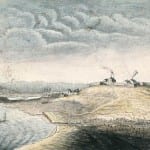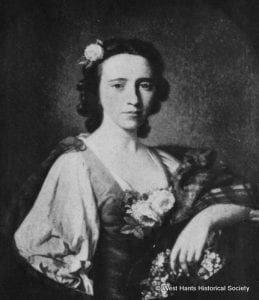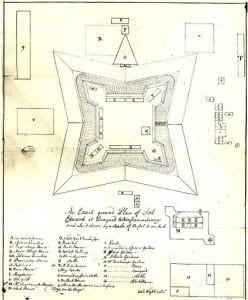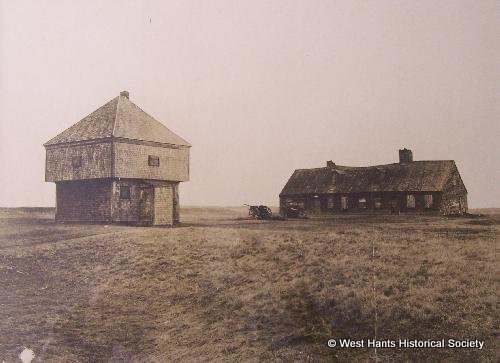Courtesy of Rev. David Curry. This is a modified version of an article that first appeared in the Hants Journal in 2008.

Strategically placed, overlooking the confluence of the St. Croix and Avon Rivers, the Blockhouse has played an interesting role in the many and varied fortunes of our Maritime and National history since its erection in 1750. Complementing and cementing the English colonial settlement of Halifax in 1749, Fort Edward belongs to those defining moments of the French/English contest for North America.
It also served as support for trading with the Native Peoples. Looking out and down the Avon towards the Minas Basin, one can imagine the comings and goings of various ships and vessels, from Mi’kmaq canoes to Acadian shallops, from barques to brigs, from sloops to schooners. In the Blockhouse itself, you can see an early form of artistic graffiti images of ships that plied the waters of the Avon in the eighteenth century, drawn, no doubt, by a bored sentinel on watch in the Blockhouse!
The Acadians and Fort Edward

It was the site, too, of some of the more somber moments in the history of displaced persons that comprises so much of the Canadian story. The Acadians, who had settled here in the late 17th century and built the dykes that contribute so significantly to the landscape even to this day, became the casualties of political loyalty in the 1750s.
A threat to the English colonial enterprises, then bent on securing land for those loyal to the English crown, Acadian neutrality was deemed insufficient and they were subject to a programme of relocation, the Expulsion of the Acadians, romanticized and immortalized in the great American poet Henry Wadsworth Longfellow’s poem “Evangeline.” While we usually associate that story with Grand Pre, it has its Fort Edward moment, too. Over a thousand Acadians were deported from the area by way of Fort Edward beginning in 1755.
As such, the Fort played a defining role in the re-settlement of the area by the New England Planters whose 250th anniversary was marked in 2010. Fort Edward was the symbol and sentinel to the English control and governance of the area.
Flora MacDonald (1722-1790), Jacobite heroine

Voltaire, in his famous romp around the world in eighty pages, his satiric novel “Candide”, published in 1759, makes mention of the French-English contests in Canada in a wonderfully dismissive and amusing fashion as being a fight over a few acres of snow, worth far less than what the war itself was costing. Fort Edward played a role in defending the various routes inland from Halifax to the Basin and the Bay of Fundy and beyond. It was even a place of sanctuary for Flora MacDonald (exiled from the Carolinas in 1778, she wintered here in 1779), who had herself provided sanctuary for Bonnie Prince Charlie on the run after the Battle of Culloden (1746), a battle which saw James Wolfe in action, too, then against the Scots Highlanders whom he would later employ in his conquest of Quebec.
The commanding figure at the Battle of Louisbourg (1758), and, of course, at Quebec, Wolfe would die in the celebrated Battle of the Plains of Abraham (1759), as did the French General, Montcalm. Wolfe’s death would be immortalized in the extravagant and exaggerated but iconic painting by Benjamin West. It would be no great mischief if they fell, Wolfe wrote, referring to the Highlanders, in a letter written before the battle, a line which the Canadian novelist Alastair MacLeod would use to great effect in his outstanding novel “No Great Mischief”.
No doubt, Flora MacDonald would have thought differently during the winter of her stay at Fort Edward in 1779, displaced (expelled) from the Carolinas during the American War of Independence (1775-1783). Somehow Fort Edward signifies in a number of the defining moments of the North American story.

A typical structure at the time, easily and quickly erected to consolidate and establish a military presence, an early form of pre-fab building, the blockhouse at Windsor is the oldest such structure in Canada and one of the very few that remain at all. There is the irony that one of the few remaining architectural structures of the period should be what can be called a “port-a-fort”!
The story of the Fort Edward Blockhouse goes on with almost no end of interesting and fascinating anecdotes and events that swirl around its almost forgotten presence. Tucked away on a hill-top in Windsor, visible from the Highway 101 if you know where and when to look, it is one of our almost forgotten treasures, a quiet sentinel to the many and varied aspects of Windsor’s rich and great heritage.
Parks Canada, in association with the West Hants Historical Society, provides an interpreter/guide offering tours and information about the Blockhouse and its place in our larger history. For more historical information on Fort Edward, go to Parks Canada’s website here.

